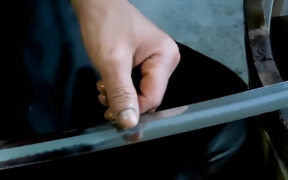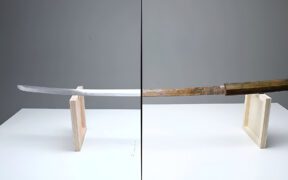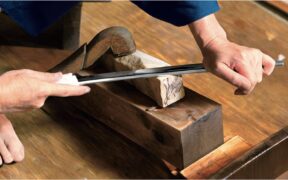Our content features commercial links to our products, committed to transparent, unbiased, and informed editorial recommendations. Learn More
Sharp and Shiny: A Simple Guide to Polishing Your Sword
NO AI USED This Article has been written and edited by our team with no help of the AI
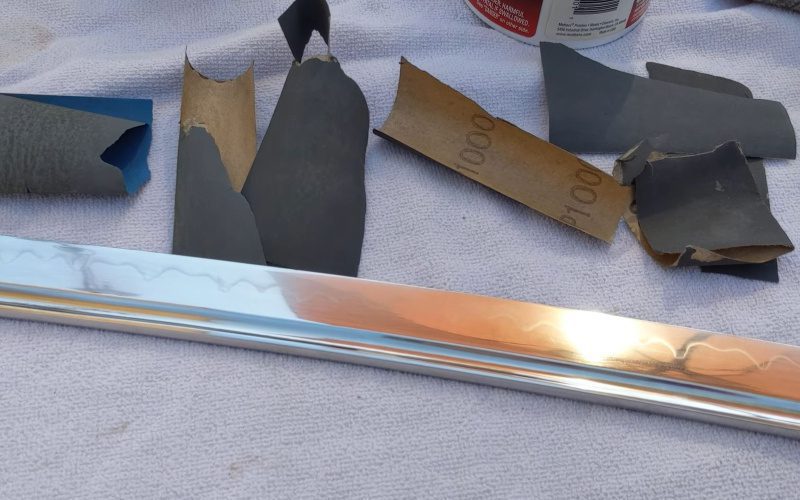
If you are the proud owner of a carbon steel sword, you should know that they need to be taken care of. As the saying goes, “if you take care of your blade, it will take care of you”. Maybe you don’t rely on your sword to keep you alive these days, but you would still want to keep it in good condition. Unfortunately, the environment is against you, so you have to make a habit of polishing your sword to keep it shiny and rust-free.
In this guide, we’ll go over everything you need to know to polish your sword and to establish a routine that will keep your swords looking like new for years to come. Be it novice or old hand, we’ve got something for you.
Let us delve into some of the basic and advanced techniques, materials, tools, solutions, and methods.
Polishing Methods
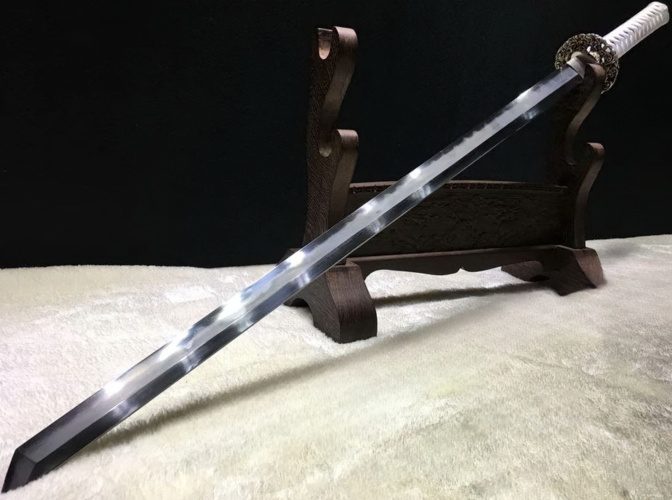
Knowing what type of sword you have is the first step to cleaning and polishing it properly. Different methods work best for different blades. Over time, you’ll learn what works for your sword. Generally, swords can be broadly divided into the following three classes:
- Antique Swords – If you have an antique sword and don’t know how to clean it, see an expert. Historical blades need special care, and you want to make sure you have the right tools and techniques to preserve this piece of history. Any mistake made could negatively impact the value of the sword.
- Stainless Steel Wall Hangers – These are ornamental and beautiful swords, art for your wall but not so good in a fight. Since their primary purpose is decorative, these blades are designed to be easy to clean. If you’ve got nothing better, window cleaner and a soft cloth can remove oil, fingerprints, and dirt. However, using something designed for stainless steel can make your sword appear mirror-like.
- Carbon Steel Functional Swords – Carbon steel swords are generally functional and can be used for cutting, sparring, and various other purposes. It’s important to maintain these swords so they keep working well for you as they need a lot more attention than a decorative sword. Be careful if it’s a sharpened blade when polishing since a high-quality blade can easily cause injuries.
Japanese Sword Polishing
If you have a Japanese sword like a Katana, Wakizashi, or even a small Tanto, you’ll need a different set of tools. Japanese swords have their own polishing styles developed for these unique blades.
There are 2 styles of Japanese sword polishing:
- Hadori style – named after the hadori, a coarse water stone that will help keep the edge pattern of the sword pale and create a lot of contrast with the darker blade.
- Sashikomi Nugui style – this style uses a mix of oils and stone powder over the whole blade. While it does lighten the hamon a little it also darkens the blade, and will only brighten up an existing edge pattern rather than creating a new one.
Japanese sword polishing happens in two steps:
- Shitaji Togi involves using either a uchigumori or hazuya whetstone to straighten out any irregularities and maintain the sleek, geometric shape of the blade.
- Shiage Togi, the second step, involves using thin slices of jizuya whetstone on small sections of the blade, or even using burnishing needles called migaki-bo to create a beautiful shine and lacquer over the kissaki, the blade’s tip.
Japanese steel blades also require a lot of care. In fact, a Togishi (professional Japanese sword polisher) is known for their steady hands and some even have a family background in sword sharpening and polishing.
What You Need
The polishing process starts before you even touch your sword: the right basics will set you up for success. Here’s what you’ll need before you get your sword out.
Peaceful Work Area
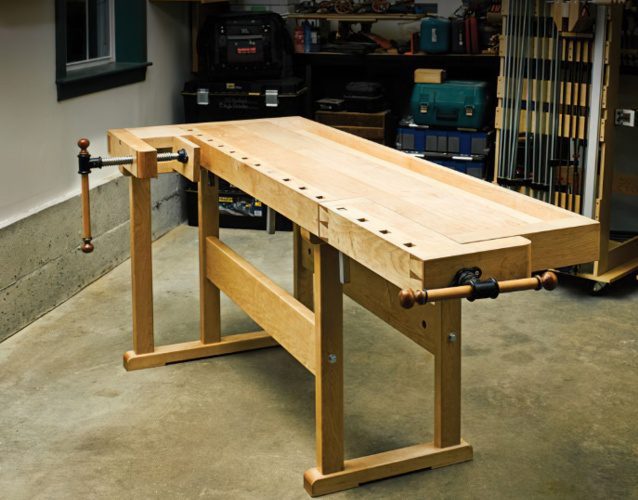
That sword you’re playing with isn’t a toy. Fun as it may be to wield, if you’re not careful with a live blade, you could end up in the hospital. Having a proper work area where you’re not going to be disturbed can ensure your safety.
Gloves and Work Surface

You’ll need a flat and stable surface large enough for the sword. Make sure your work area is properly lit so you can see the sword clearly. You’ll also want to put down a soft cloth or old shirt to protect your sword and work surface. Having a pair of cut-resistant gloves can keep your fingerprints off the freshly-polished surface and keep your hands safe from the blade.
Oil or Metal Polish
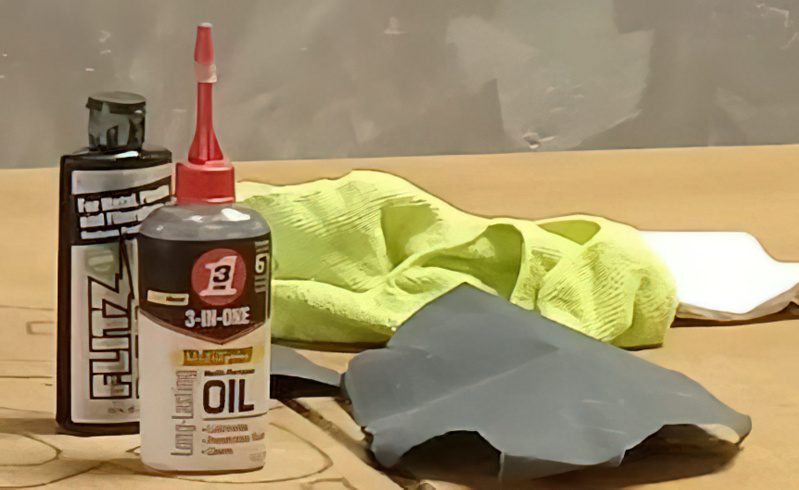
Oil – the right kind of oil – is great for cleaning and protecting your sword. 3-in-one oil is great: it’s a synthetic mineral-based oil that protects from humidity, rust, and lasts for a long time. Other light to medium-weight oils will also work well. WD40, for example, is both effective and easy to get a hold of.
Don’t cheap out and raid your kitchen as vegetable oil and water can damage the blade and loosen the handle. The last thing you want is your blade to start wiggling or go flying off during a match.
If the smell and feel of the oil bothers you, metal polish also works! If the sword has come in contact with water, or been on display somewhere damp, metal polish is probably the way you want to go. A lot of experienced sword polishers recommend Flitz.
Wet/Dry Sandpaper
This stuff is made to work on metal and can help you get heavy rust, scuffing, and scratches off your sword. It can sharpen the blade as well, but make sure to pay attention to the grit number. The lower the number, the bigger the pieces on the sandpaper will be: too high and you’ll get no traction, too low and you’ll leave visible marks.
A good method is to have one piece of wet/dry sandpaper at 500, and a second piece at 1000: a combination of the two will work for most swords.
Cloth or Paper Towel
Lint-free cloths are your best option for polishing a sword–they’re made to provide even swipes for polishing and are easy to hold. However, any clean soft cloth will do. If you don’t want to ruin the cloth with sword oil, you can apply it with a paper towel.
Polishing Guide

Step 1 – Rest the Sword Horizontally
Put your sword down horizontally. It doesn’t matter which side is touching the work surface for now, since you’ll be polishing both edges. Don’t forget the cloth underneath to keep it steady and avoid scratches.

Step 2 – Oil the Blade or Sandpaper
Take out your oil and dab the sandpaper or blade itself. A thin layer of oil will do as too much will attract dust and moisture.

Step 3 – Polish the Blade
Start at the base of the blade. Using the oiled paper, follow the grain of the blade down to the tip and then back up again. Begin with the 1000 grit sandpaper. You should see rust and dirt coming away from the blade.
When polishing the sword, it can be done with it resting on the table, or you can hold the handle and lift it for swifter and easier motions.

Step 4 – Wipe with Paper Towel
Once you’ve oiled and scrubbed your blade with the sandpaper, wipe it down with a paper towel. Slow, horizontal motions will remove the oil and any stain marks.

Step 5 – Apply Metal Polish
If you’re using metal polish, shake it and apply a thin line across the surface of the blade. Take a fresh paper towel and spread the polish all along the blade, using the same motions as in step 3. As it starts drying, you’ll see the bright, polished blade underneath.

Step 6 – Wipe with Cloth
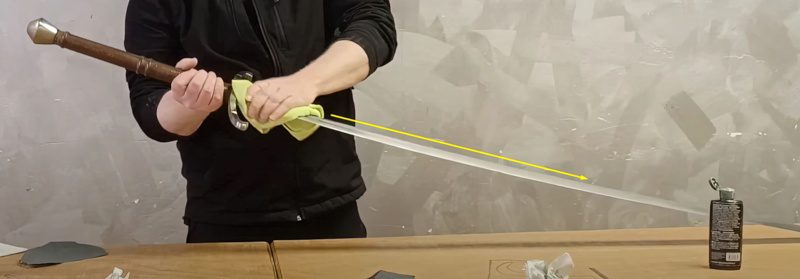
Take a dry, lint-free cloth and hug the blade from both sides just above the guard as seen in the image above. Hold it tightly–but be careful of the edge–and move it in a singular motion toward the blade’s tip. Make sure to wipe off any extra oil, polish, or fingerprints.
How Often Should You Polish?
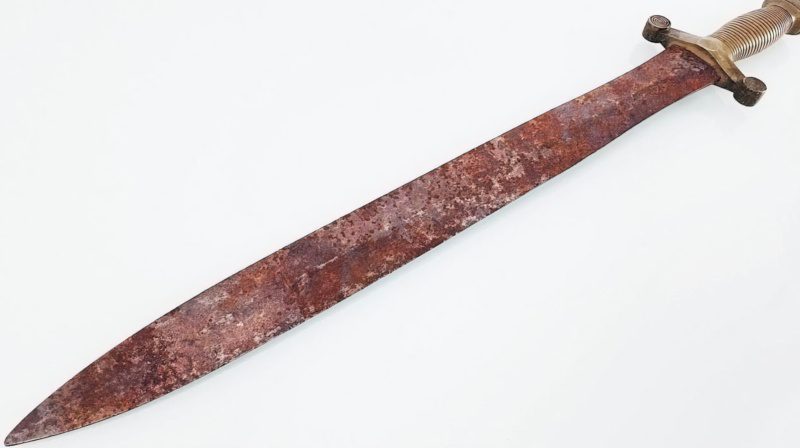
How often you polish your sword depends on the purpose of your sword and how you use it. Untouched display swords that are kept in a cool, dry place can go up to six months without being polished. However, swords that are handled frequently or are stored in a damp environment will require polishing every two weeks for optimal maintenance.
Those who use the sword for cutting will need to polish the sword after each use. This ensures that nothing adheres to the blade. For example, food, water, and fingerprints can actually cause the blade to corrode over time and shorten its lifespan.
Conclusion
Whether you own a 19th-century sabre or a Japanese Katana, your sword needs proper maintenance to keep it in good condition. Unless you have a squire handy or plan to send your sword off to a professional sword polisher, learning to clean and maintain your sword is critical for both beginners and experts alike.

